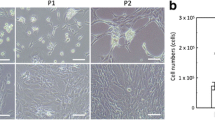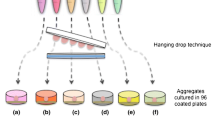Abstract
Fetal chondrocytes (FCs) have recently been identified as an alternative cell source for cartilage tissue engineering applications because of their partially chondrogenically differentiated phenotype and developmental plasticity. In this study, chondrocytes derived from fetal bovine cartilage were characterized and then cultured on commercially available Cytodex-1 and Biosilon microcarriers and thermosensitive poly(hydroxyethylmethacrylate)-poly(N-isopropylacrylamide) (PHEMA-PNIPAAm) beads produced by us. Growth kinetics of FCs were estimated by means of specific growth rate and metabolic activity assay. Cell detachment from thermosensitive microcarriers was induced by cold treatment at 4 °C for 20 min or enzymatic treatment was applied for the detachment of cells from Cytodex-1 and Biosilon. Although attachment efficiency and proliferation of FCs on PHEMA-PNIPAAm beads were lower than that of commercial Cytodex-1 and Biosilon microcarriers, these beads also supported growth of FCs. Detached cells from thermosensitive beads by cold induction exhibited a normal proliferative activity. Our results indicated that Cytodex-1 microcarrier was the most suitable material for the production of FCs in high capacity, however, ‘thermosensitive microcarrier model’ could be considered as an attractive solution to the process scale up for cartilage tissue engineering by improving surface characteristics of PHEMA-PNIPAAm beads.







Similar content being viewed by others
References
Anghileri LJ, Dermietzel R (1976) Cell coat in tumour cells—effects of trypsin and EDTA: a biochemical and morphological study. Oncology 33:17–23
Au A, Ha J, Polotsky A, Krzyminski K, Gutowska A, Hungerford DS, Frondoza CG (2003) Thermally reversible polymer gel for chondrocyte culture. J Biomed Mater Res A 67:1310–1319
Baker T, Goodwin T (1997) Three-dimensional culture of bovine chondrocytes in rotating-wall vessels. In Vitro Cell Dev Biol Anim 33:358–365
Benya PD, Shaffer JD (1982) Dedifferentiated chondrocytes reexpress the differentiated collagen phenotype when cultured in agarose gels. Cell 30:215–224
Bouchet B, Colon M, Polotsky A, Shikani AH, Hungerford DS, Frondoza CG (2000) Beta-1 integrin expression by human nasal chondrocytes in microcarrier spinner culture. J Biomed Mater Res 52:716–724
Canavan HE, Cheng X, Graham DJ, Ratner BD, Castner DG (2005) Cell sheet detachment affects the extracellular matrix: a surface science study comparing thermal liftoff, enzymatic, and mechanical methods. J Biomed Mater Res A 75:1–13
Chen JP, Cheng TH (2006) Thermoresponsive chitosan-graft-poly(N-isopropylacrylamide) injectable hydrogel for cultivation of chondrocytes and meniscus cells. Macromol Biosci 6:1026–1039
Dowthwaite GP, Bishop JC, Redman SN, Khan IM, Rooney P, Evans DJR, Haughton L, Bayram Z, Boyer S, Thomson B, Wolfe MS, Archer CW (2004) The surface of articular cartilage contains a progenitor cell population. J Cell Sci 117:889–897
Freed LE, Vunjak-Novakovic G, Langer R (1993) Cultivation of cell–polymer cartilage implants in bioreactors. J Cell Biochem 51:257–264
Freshney IR (2005) culture of animal cells a manual of basic technique, 5th edn. Wiley, New York, p 208
Frondoza C, Sohrabi A, Hungerford D (1996) Human chondrocytes proliferate and produce matrix components in microcarrier suspension culture. Biomaterials 17:879–888
Fujioka N, Morimoto Y, Takeuchi K, Yoshioka M, Kikuchi M (2003) Difference in infrared spectra from cultured cells dependent on cell-harvesting method. Appl Spectro 57:241–243
Giard D (1986) Detachment of anchorage dependent cells from microcarriers, World Intellectual Property Organization International Bureau WO 86/01531
Gümüşderelioğlu M (2011) Development of temperature-sensistive microcarriers for large scale cell cultures, Turkish Scientific and Research Council Project (109M228) Report
GE Healthcare (2005) Microcarrier cell culture: principles and methods. General Electric Company
Jasionowski M, Kryminski K, Chrisler W, Markille LM, Morris J, Gutowska A (2004) Thermally-reversible gel for 3-D cell culture of chondrocytes. J Mat Sci Mater Med 15:575–582
Jung K, Hampel G, Scholz M, Henke W (1995) Culture of human kidney proximal tubular cells—the effect of various detachment procedures on viability and degree of cell detachment. Cell Physiol Biochem 5:353–360
Kim MR, Jeong JH, Park TK (2002) Swelling induced detachment of chondrocytes using RGD-modified poly(N-isopropylacrylamide) hydrogel beads. Biotechnol Prog 18:495–500
Kim DJ, Heo J-y, Kim KS, Choi IS (2003) Formation of thermoresponsive poly(N-isopropylacrylamide)/dextran particles by atom transfer radical polymerization. Macromol Rapid Commun 24(8):517–521
Kiremitçi M, Çukurova H (1992) Production of highly crosslinked hydrophilic polymer beads:effect of polymerization conditions on particle size and size distribution. Polymer 33(15):3257–3261
Lopes AAB, Peranovich TMS, Maeda NY, Bydlowski SP (2001) Differential effects of enzymatic treatments on the storage and secretion of von Willebrand factor by human endothelial cells. Thromb Res 101:291–297
Mahmoudifar N, Doran PM (2005) Tissue engineering of human cartilage and osteochondral composites using recirculation bioreactors. Biomaterials 34:7012–7024
Mahmoudifar N, Doran PM (2006) Effect of seeding and bioreactor culture conditions on the development of human tissue-engineered cartilage. Tissue Eng 12:1675–1685
Malda J, Frondoza CG (2006) Microcarriers in the engineering of cartilage and bone. Trends Biotechnol 7:299–304
Malda J, Kreijveld E, Temenoff JS, van Blitterswijk CA, Riesle J (2003) Expansion of bovine chondrocytes on microcarriers enhances redifferentiation. Tissue Eng 9:939–948
Martin JM, Smith M, Al-Rubeai M (2005) Cryopreservation and in vitro expansion of chondroprogenitor cells isolated from the superficial zone of articular cartilage. Biotechnol Prog 21:168–177
Melero-Martin JM, Dowling MA, Smith M, Al-Rubeai M (2006) Expansion of chondroprogenitor cells on macroporous microcarriers as an alternative to conventional monolayer systems. Biomaterials 27:2970–2979
Montjovent MO, Bocelli-Tyndall C, Scaletta C, Scherberich A, Mark S, Martin I, Applegate LA, Pioletti DP (2009) In vitro characterization of immune-related properties of human fetal bone cells for potential tissue engineering applications. Tissue Eng Part A 15:1523–1532
Parsch D, Brummendorf TH, Richter W, Fellenberg J (2002) Replicative aging of human articular chondrocytes during ex vivo expansion. Arthritis Rheum 46:2911–2916
Pioletti DP, Montjovent MO, Zambelli PY, Applegate L (2006) Bone tissue engineering using foetal cell therapy. Swiss Med Wkly 136:557–560
Quintin A, Schizas C, Scaletta C, Jaccoud S, Applegate LA, Pioletti DP (2010) Plasticity of fetal cartilaginous cells. Cell Transpl 19:1349–1357
Reiners JJ, Mathieu P, Okafor C, Putt DA, Lash L (2000) Depletion of cellular glutathione by conditions used for the passaging of adherent cultured cells. Toxicol Lett 115:153–163
Silva R, Mano JF, Reis RL (2007) Smart thermoresponsive coatings and surfaces for tissue engineering: switching cell-material boundaries. Trends Biotechnol 25:577–583
Umegaki R, Masahiro KO, Taya M (2004) Assessment of cell detachment and growth potential of human keratinocyte based on observed changes in individual cell area during trypsinization. Biochem Eng J 17:49–55
Varani J, Dame M, Rediske J, Beals TF, Hillegas W (1985) Substrate-dependent differences in growth and biological properties of fibroblasts and epithelial cells grown in microcarrier culture. J Biol Stand 13:67–76
Varani J, Bnedelow M, Chun JH, Hillegas WA (1986) Cell growh on microcarriers: comparison of proliferation on and recovery from various substrates. J Biol Stand 14:331–336
Von der Mark K, Gauss V, von der Mark H, Mueller P (1977) Relationship between cell shape and type of collagen synthesized as chondrocytes lose their cartilage phenotype in culture. Nature 267:531–532
Weber C, Pohl S, Portner R, Wallrapp C, Kassem M, Geigle P, Czermak P (2007) Expansion and harvesting of hMSC-TERT. Open Biomed Eng J 1:38–46
Acknowledgments
The authors are grateful to Sakir Sekmen for his assistance in obtaining tissue samples; to Melis Denizci Öncü for the critical reading. This study was partly supported by TURKHAYGEN-1 Project (The Scientific and Technological Research Council of Turkey,TUBITAK, KAMAG-106G005) and also TUBITAK Project No.109M228.
Author information
Authors and Affiliations
Corresponding author
Rights and permissions
About this article
Cite this article
Çetinkaya, G., Kahraman, A.S., Gümüşderelioğlu, M. et al. Derivation, characterization and expansion of fetal chondrocytes on different microcarriers. Cytotechnology 63, 633–643 (2011). https://doi.org/10.1007/s10616-011-9380-7
Received:
Accepted:
Published:
Issue Date:
DOI: https://doi.org/10.1007/s10616-011-9380-7




